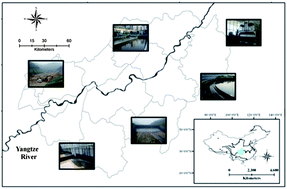Occurrence and removal of endocrine-disrupting chemicals in wastewater treatment plants in the Three Gorges Reservoir area, Chongqing, China
Abstract
Concentrations of six endocrine-disrupting compounds (EDCs), bisphenol A (BPA),

* Corresponding authors
a
Key Laboratory of Urban Environment and Health, Institute of Urban Environment, Chinese Academy of Sciences, Xiamen 361021, China
E-mail:
shchen@iue.ac.cn
Fax: +86 592 6190977
Tel: +86 592 6190995
b Research Center for Eco-Environmental Sciences, Chinese Academy of Sciences, Beijing 100085, China
c Fujian Academic of Agricultural Sciences, Fuzhou, China
Concentrations of six endocrine-disrupting compounds (EDCs), bisphenol A (BPA),

 Please wait while we load your content...
Something went wrong. Try again?
Please wait while we load your content...
Something went wrong. Try again?
X. Ye, X. Guo, X. Cui, X. Zhang, H. Zhang, M. K. Wang, L. Qiu and S. Chen, J. Environ. Monit., 2012, 14, 2204 DOI: 10.1039/C2EM30258F
To request permission to reproduce material from this article, please go to the Copyright Clearance Center request page.
If you are an author contributing to an RSC publication, you do not need to request permission provided correct acknowledgement is given.
If you are the author of this article, you do not need to request permission to reproduce figures and diagrams provided correct acknowledgement is given. If you want to reproduce the whole article in a third-party publication (excluding your thesis/dissertation for which permission is not required) please go to the Copyright Clearance Center request page.
Read more about how to correctly acknowledge RSC content.
 Fetching data from CrossRef.
Fetching data from CrossRef.
This may take some time to load.
Loading related content
